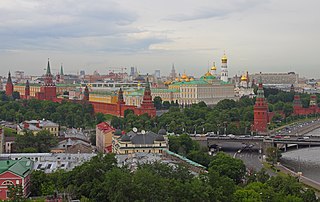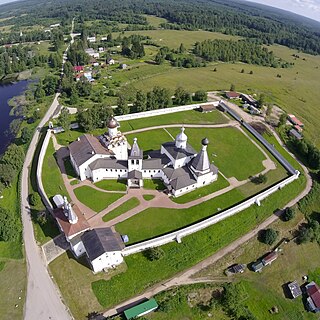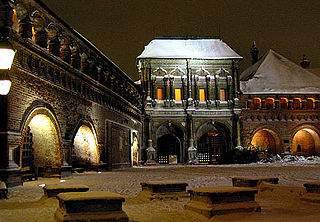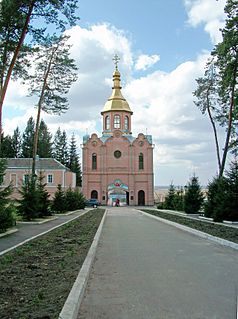
Red Square is one of the oldest and largest squares in Moscow, the capital of Russia. Owing to its historical significance and the adjacent historical buildings, it is regarded as one of the most famous squares in Europe and the world. It is located in Moscow's historic centre, in the eastern walls of the Kremlin. It is the city landmark of Moscow, with iconic buildings such as Saint Basil's Cathedral, Lenin's Mausoleum and the GUM. In addition, it has been a UNESCO World Heritage Site since 1990.

The Cathedral of Vasily the Blessed, commonly known as Saint Basil's Cathedral, is an Orthodox church in Red Square of Moscow, and is one of the most popular cultural symbols of Russia. The building, now a museum, is officially known as the Cathedral of the Intercession of the Most Holy Theotokos on the Moat, or Pokrovsky Cathedral. It was built from 1555 to 1561 on orders from Ivan the Terrible and commemorates the capture of Kazan and Astrakhan. It was the city's tallest building until the completion of the Ivan the Great Bell Tower in 1600.

The Kremlin is a fortified complex in the centre of Moscow founded by the Rurikids ruling dynasty. It is the best known of the kremlins, and includes five palaces, four cathedrals, and the enclosing Kremlin Wall with Kremlin towers. In addition, within this complex is the Grand Kremlin Palace that was formerly the Tsar's Moscow residence. The complex now serves as the official residence of the President of the Russian Federation and as a museum with almost 3 million visitors in 2017. The Kremlin overlooks the Moskva River to the south, Saint Basil's Cathedral and Red Square to the east, and the Alexander Garden to the west.

Kyiv-Pechersk Lavra or Kyivo-Pechers’ka Lavra (Ukrainian: Києво-Печерська лавра, romanized: Kyievo-Pecherska lavra;, also known as the Kyiv Monastery of the Caves, is a historic Eastern Orthodox Christian monastery which gave its name to one of the city districts where it is located in Kyiv.

The Trinity Lavra of St. Sergius is the most important Russian monastery and the spiritual centre of the Russian Orthodox Church. The monastery is situated in the town of Sergiyev Posad, about 70 km to the north-east from Moscow by the road leading to Yaroslavl, and currently is home to over 300 monks.

The Chudov Monastery was founded in the Moscow Kremlin in 1358 by Metropolitan Alexius of Moscow. The monastery was dedicated to the miracle of the Archangel Michael at Chonae. The Monastery was closed in 1918, and dismantled in 1929.

The Ferapontov convent, in the Vologda region of Russia, is considered one of the purest examples of Russian medieval art, a reason given by UNESCO for its inscription on the World Heritage List.

Kirillo-Belozersky Monastery, translated into English as White Lake [translation of the town name of Beloozero] St. Cyril's Monastery, used to be the largest monastery and the strongest fortress in Northern Russia. The monastery was consecrated to the Feast of the Dormition of the Theotokos, for which cause it was sometimes referred to as the Dormition Monastery of St. Cyril. By the 20th century, the town of Kirillov had grown nearby.

A tented roof is a type of polygonal hipped roof with steeply pitched slopes rising to a peak. Tented roofs, a hallmark of medieval religious architecture, were widely used to cover churches with steep, conical roof structures.

Krutitsy Metochion, full name: Krutitsy Patriarchal Metochion is an operating ecclesiastical estate of Russian Orthodox Church, located in Tagansky District of Moscow, Russia, 3 kilometers south-east from the Kremlin. The name Krutitsy (pl.), i.e. steep river banks, originally meant the hills immediately east from Yauza River. Krutitsy Metochion, established in the late 13th century, contains listed historical buildings erected in the late 17th century on the site of earlier 16th century foundations. After a brief period of prosperity in the 17th century, Krutitsy was shut down by imperial authorities in the 1780s, and served as a military warehouse for nearly two centuries. It was restored by Petr Baranovsky and gradually opened to the public after World War II; in 1991-1996, Krutitsy was returned to the Church and re-established as the personal metochion of Patriarch of Moscow and all Russia.

Russian architecture follows a tradition whose roots lie in early Russian stone architecture and in the architecture of Kievan Rus' with its centers in Veliky Novgorod and Kiev. From the Rus' era, the Byzantine Empire and Islamic architecture influenced the architecture and people of Russia. In other phases of Russian history the architecture developed independently and was characterized by national and local features. After the Mongol invasion of Rus, Russian architectural history continued in the principalities of Vladimir-Suzdal, Novgorod, and the succeeding states of the Tsardom of Russia. The great churches of Kievan Rus', built after the adoption of Christianity in 988, were the first examples of monumental architecture in the East Slavic region. Early Eastern Orthodox churches were mainly built from hay, with their simplest form known as a cell church. Cathedrals often featured many small domes, which has led some art historians to infer how the pagan Slavic temples may have appeared.

Holy Dormition Pochayiv Lavra is a monastery in Pochayiv, Kremenets Raion, Ternopil Oblast, Ukraine. The monastery belongs to the Ukrainian Orthodox Church. For centuries, it has been the foremost spiritual and ideological centre of various Orthodox and Eastern Catholic denominations in Western Ukraine. The monastery tops a 60-metre hill in the town of Pochayiv, 18 km southwest of Kremenets and 70 km north of Ternopil.

Vysokopetrovsky Monastery is a Russian Orthodox monastery in the Bely Gorod area of Moscow, commanding a hill whence Petrovka Street descends towards the Kremlin.

Serafimo-Diveevsky Monastery, or Saint Seraphim-Diveyevo Monastery, or Holy Trinity-Saint Seraphim-Diveyevo Monastery is a monastery of nuns (convent) in Diveyevo settlement near Sarov (12 km), and near the city of Nizhny Novgorod (185 km), in the Nizhny Novgorod Oblast, Russia. It is situated in a region considered to have immense spiritual significance. Within its immediate vicinity are situated two other cloisters: those of Sarov and Sanaxar.

The Savvino-Storozhevsky Monastery is a Russian Orthodox monastery dedicated to the feast of the Nativity of the Theotokos. It is the preeminent landmark of Zvenigorod, a town located 48 km (30 mi) west of Moscow.

Bartholomew Remov was a Russian Orthodox archbishop who secretly converted to the Russian Greek Catholic Church in 1932. He was sentenced to death in 1935 by the Military Collegium of the Supreme Court of the Soviet Union on charges of anti-Soviet agitation and espionage on behalf of the Holy See and executed soon after.

December 25 – Eastern Orthodox liturgical calendar – December 27

The Glinsk Hermitage is a Russian Orthodox stavropegial monastery located in Ukraine, near the Russian border. In the 19th and early 20th centuries it was a major spiritual center of the Russian Orthodox Church, and many of its elders have been recently canonized as saints. The monastery is under the Ukrainian Orthodox Church in the diocese of Konotop and Hlukhiv.
Church of the Nativity of Mary, may refer to:

The Alexander Nevsky Cathedral is a Russian Orthodox cathedral church located in the Kanavinsky city district of Nizhny Novgorod. The cathedral is located on the former territory of the Nizhny Novgorod Fair. It is one of the unofficial symbols of Nizhny Novgorod, along with the Dmitrovskaya Tower of the Kremlin, the Chkalov staircase and the fair.


















